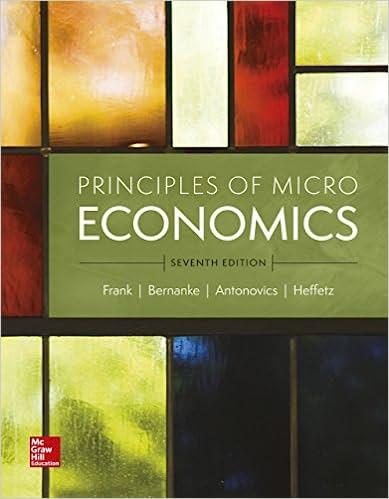Question
Assume a nation is operating on its production possibilities frontier which consists of producing a mix of defense and non-defense goods and services. If resources
Assume a nation is operating on its production possibilities frontier which consists of producing a mix of defense and non-defense goods and services. If resources are deployed to produce more defense goods and services, an opportunity cost of this decision is:
a. The cost savings to taxpayers from no longer having to pay for as many non-defense goods and services such as health care
b. The additional income earned by military personnel and defense contractors
c. The benefits of increased national security
d. The loss of non-defense goods and services such as health care goods and services
Which of the following would NOT be expected to increase the U.S. production possibilities frontier?
a. Better education and worker training
b. Scientific research and the development of new technologies
c. Stricter laws to prevent labor immigration into the U.S.
d. Business investment in capital resources that improve labor productivity
Which of the following would be expected to result in an increase in total employment and an increase in the general price level?
a. An increase in aggregate demand
b. A decrease in aggregate demand
c. A decrease in aggregate supply
d. An increase in aggregate supply
Which of the following would be expected to result in a decrease in Gross Domestic Product (GDP) and an increase in the general price level (P)?
a. An increase in aggregate demand
b. A decrease in aggregate demand
c. A decrease in aggregate supply
d. An increase in aggregate supply
Some U.S. businesses have objected to proposed "buy American" legislation that would require U.S. businesses to purchase only U.S. labor and other American-made inputs to produce their goods and services on the grounds that it would raise their costs and disrupt the supply chains that they have established with foreign businesses. Based on these concerns, which of the following describes the most likely effect of legislating a "buy American" policy?
a. Restrictions on purchasing foreign labor and other foreign inputs will shift the U.S. aggregate supply curve outward (to the right) and increase total production in the U.S. economy.
b. Restrictions on purchasing foreign labor and other foreign inputs will shift the U.S. aggregate supply curve inward (to the left) and decrease total production in the U.S. economy.
c. Restrictions on purchasing foreign labor and other foreign inputs will increase the U.S. price level because the U.S. aggregate supply curve will shift outward (to the right) due to higher input costs.
d. Restrictions on purchasing foreign labor and other foreign inputs will have no effect on the U.S. aggregate supply curve if foreign countries enact similar restrictions on the use of U.S. labor and other inputs.
To counteract a recession, a Keynesian economist would be expected to support which of the following fiscal policies as a means of stimulating aggregate demand?
a. A tax cut for households accompanied by an equal decrease in government purchases so as not to increase the budget deficit
b. Increased transfer payments to the unemployed accompanied by an equal increase in taxes on higher income households who have a lower marginal propensity to consume than households with unemployed workers
c. Increased transfer payments to the unemployed accompanied by an equal decrease in government purchases
d. Decreased transfer payments to the unemployed with no accompanying changes in government purchases or taxes.
Assume the Fed buys $20 million of government bonds from someone who deposits the Fed's check in the Chase National Bank. If the required reserve ratio is 25 percent, the initial change in excess reserves in the banking system and the maximum increase in the money supply caused by the Fed's action are:
a. $15 million and $60 million
b. $5 million and $80 million.
c. $15 million and $80 million.
d. $5 million and $40 million.
A consistent anti-inflationary monetary policy enacted by the Fed would consist of:
a. The Fed selling government securities and lowering its discount rate
b. The Fed buying government securities and raising its discount rate
c. The Fed selling government securities and raising its discount rate
d. The Fed buying government securities and lowering its discount rate
In Northland, it takes a worker 2 days to produce 1000 yards of cloth and 4 days to produce 1200 pounds of steel.In Southland, a worker takes 1 day to produce 1000 yards of cloth and 3 days to produce 1200 pounds of steel. If these are the only two goods that can be traded between the two countries and both countries have a goal of maximizing the consumption possibilities of its inhabitants, we would expect
a. Southland to import both goods
b. Southland to export steel and Northland to export cloth
c. Northland to export steel and Southland to export cloth.
d. Northland to import both goods
If the U.S. dollar depreciates in value relative to the European euro, then U.S. imports from Europe will become ______(more/less) expensive and aggregate demand for U.S. goods and services will ________(increase/decrease).
a. More; Increase
b. More; Decrease
c. Less; Increase
d. Less; Decrease
Step by Step Solution
There are 3 Steps involved in it
Step: 1

Get Instant Access to Expert-Tailored Solutions
See step-by-step solutions with expert insights and AI powered tools for academic success
Step: 2

Step: 3

Ace Your Homework with AI
Get the answers you need in no time with our AI-driven, step-by-step assistance
Get Started


